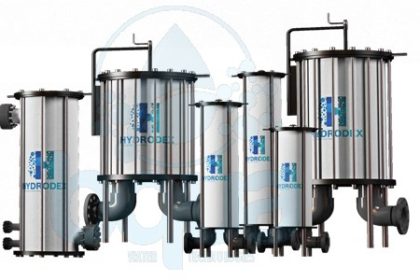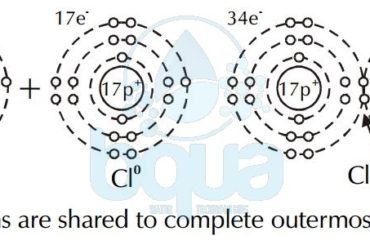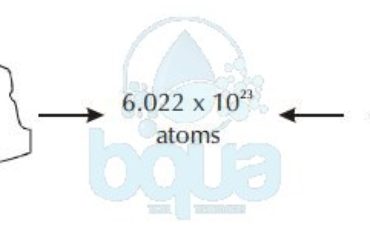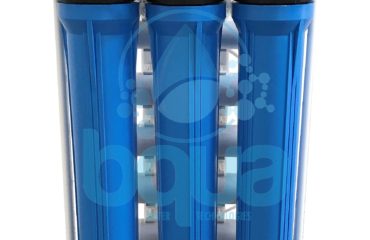
What is a Cartridge Filter Definition
A Cartridge filter is a fine microfilter of nominal size from 1 to 25 um (micron) made of thin plastic fibers or other fine filtration media that is installed around a central tube to form a standard-size cartridge. Cartridge Filters are often used as the only screening device between the intake wells and the Reverse Osmosis system. This is in case of brackish and seawater desalination plants with well intakes producing high-quality source water. Cartridge filters are RO membrane protection facilities rather than screening devices; the main purpose they serve is to capture particulates in the pretreated source water that may have passed through the upstream pretreatment systems in order to prevent damage or premature fouling of the RO membranes.
Although wound (spun) polypropylene filter cartridges are most commonly used for seawater and brackish water applications. Other types, such as melt-blown or pleated cartridges of other materials have also found application. Standard cartridge filters for RO desalination plants are typically 101.6 to 1524 cm (40 to 60 in.) long. And are installed in either horizontal or vertical pressure vessels (filter housings). Cartridges are rated for removal of particles of 1, 2, 5, 10, or 25 um, with the most frequently used size being 5 um.
Fig. 1: Example on Cartridge Filter Housing Manufacturer: Hydrodex Filter Housings
It is useful to mention that Hydrodex is one of the market leaders in the filtration industry. Hydrodex manufactures a premium cartridge filter made of Glass Reinforced Polymer (GRP).
Cartridge Filter Planning and Design Considerations
Cartridge filters are typically installed downstream of the granular media filtration system. That is in case such a system is used for pretreatment to capture fine sand, particles, and silt that may be contained in the pretreated water. When the source seawater is of very high quality – a silt density index (SDI) below 2 – and does not need particulate removal by filtration prior to desalination. In this case cartridge filters are used as the only pretreatment device. Serving as a barrier to capture fine silt and particulates that can occasionally enter the source water during the start-up of intake well pumps or due to failure of intake equipment or piping.
Cartridge Filter in Horizontal Orientation
A typical indication of whether the pretreatment system of a given desalination plant operates properly is the SDI reduction through the cartridge filters. If the pretreatment system performs well, then the SDI of the source water upstream and downstream of the cartridge filters is approximately the same. If the cartridge filters consistently reduce the SDI of the filtered source water by over 1 unit. This means that the upstream pretreatment system is not functioning properly. Sometimes the SDI of the source water increases when it passes through the cartridge filters. This almost always occurs because the cartridge filters have not been designed properly or are malfunctioning and providing conditions for growth of biofouling microorganisms on and within the filters.
A frequently debated question is whether cartridge filters are needed downstream of MF or UF membrane pretreatment systems. Taking into consideration that the cartridge filter pores are one to two orders of magnitude larger than those of the membrane filters. The answer to this question is highly dependent on the quality of the pretreatment membrane’s fiber material. And the type of flow pattern through the pretreatment system.
For UF or MF filtration systems that have a direct flow-through pattern. Where the desalination plant feed pumps convey water directly through the membrane pretreatment system without an interim pumping. The pretreatment membranes are more likely to be exposed to pressure surges. If the fiber material of the pretreatment membranes is weak and breaks easily under pressure surge conditions, the pretreatment system is more likely to experience fiber breaks. Broken membrane fibers will release small amounts of particles into the RO feed water. Which could cause accelerated membrane fouling unless it is captured by cartridge filtration.
In addition, if the broken membrane fibers release sharp particles contained in the source water, these particles could also damage the RO membranes. Sharp broken-shell particles may find their way into the UF or MF pretreated water if shellfish plankton contained in the source water passes through the microscreens. Grows to adult shellfish organisms (e.g., barnacles) on the walls of the pretreatment system feed pump station. And releases portions of shells that have been broken into small, sharp particles by the feed pumps.
The shell particles will be pressurized onto the UF/MF membrane filter fibers, causing punctures and ultimately entering the filtered flow. In such cases, the use of cartridge filters downstream of the membrane pretreatment system is a prudent engineering practice. Cartridge filters are operated under pressure, and the differential pressure across them is monitored to aid in determining when filter cartridges should be replaced. In addition, valved sample ports should be installed immediately upstream and downstream of the cartridge filter vessels for water quality sampling and monitoring (including SDI field testing).
Cartridge filtration systems are designed for hydraulic loading rates of 0.2 to 0.3 L/s per 250 mm (3 to 5 gal/min per 10 in.) of length. Additional filtration capacity is normally provided to allow replacement of cartridges without interruption of water production. Pressure vessels are typically constructed of duplex stainless steel for seawater RO installations.
The pressure drop across a clean cartridge filter is usually specified as less than 0.2 bar (2.8 lb/in2). Commonly, cartridges are replaced when the filter differential pressure reaches 0.7 to 1.0 bar (10.1 to 14.5 lb/in2). The operational time before replacement depends on the source water quality and the degree of pretreatment. Typically, a cartridge filter replacement is needed once every 6 to 8 weeks. However, if the source seawater is of very good quality cartridge filters may not need replacement for 6 months or more.
For RO systems where sand in the feed water might be anticipated. Rigid meltblown cartridges or cartridge filters with single open ends and dual O-rings on the insertion nipple. Rather than conventional cartridges with dual open ends, are commonly used. The single-open-end insertion filters have positive seating and an insertion plate. Which does not allow deformation of the filter cartridge under pressure caused by sand packing. Double-open-end cartridge filters are held in place by a spring-loaded pressure plate.
Design Example of a Cartridge Filter
This example presents the sizing and configuration of the cartridge filtration system for a 40,000 m3/day (10.6 mgd) seawater desalination plant. With a total plant seawater intake flow of 98,440 m3/day (26 mgd).
| Design feed flow, Qin | 98,440 m3/day = 1140 L/s |
| Cartridge filter material | Pleated polypropylene |
| Cartridge filter size | 5 um (micron) |
| Cartridge filter length, Lcf | 1016 mm (40 in.) |
| Selected design loading rate, DLR | 0.25 L/s per 250 mm |
| Number of cartridge filters needed | Qin/[DLR x (Lcf/250)] (8.1) = 1140/[0.25 x (1016/250)] = 1122 |
| Number of cartridge vessels | 6 (selected to match RO trains) |
| Cartridge vessel material | Glass-reinforced plastic |
| Number of filter cartridges per vessel | 1122/6 = 187 (selected 180) |
| Actual cartridge filter loading rate | 1140/[180 x 6 x (1016/250)] = 0.26 L/s per 250 mm (4.2 gal/min per 10 in.) |
In summary, the cartridge filtration system for the 40,000 m3/day (10.6 mgd) desalination plant will consist of six cartridge vessels. Each of which will contain 180 cartridge filters of size 5 μm and length 40 in.




